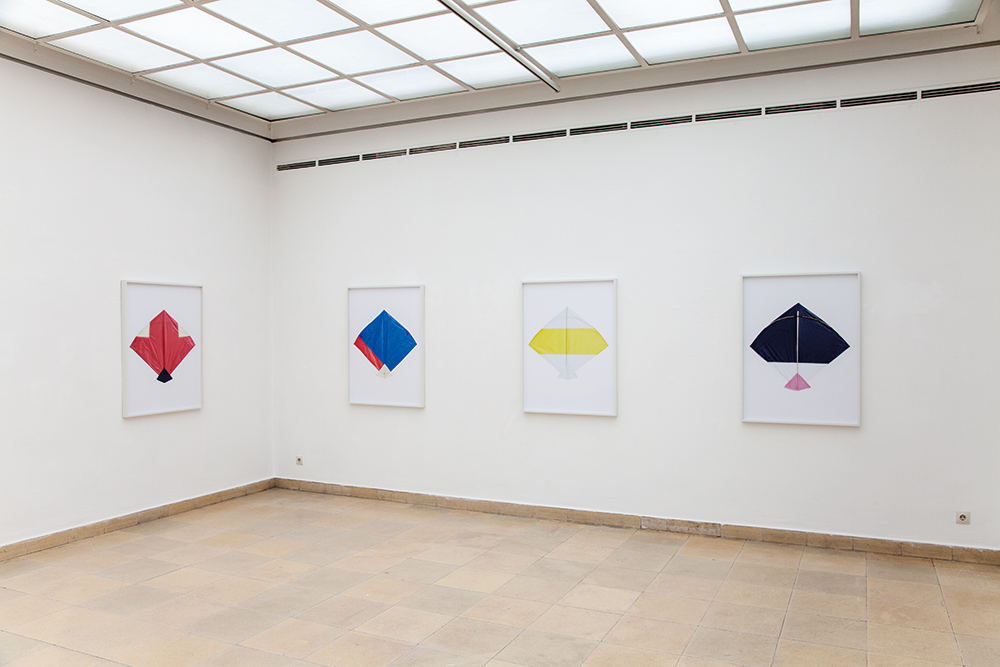




THE MECHANICS OF FORM
Kunstpavillon Tiroler Künstlerschaft, Innsbruck (AT)
28.06.2012 – 11.07.2012
Curator:
Ingeborg Erhart (AT)
At the front, nine slabs of concrete lay arranged in an oblong. It was probably not by chance that they had the same dimensions as the floor tiles of the exhibition space. To the left of them, a simple metal rod was leaning; hung on this was the kind of hoop used by artistes.
Suddenly, the geometrical volumes at the back began to move, each in the same way. Mounted on pedestal constructions like those that customarily carry brightly-colored riding animals or other flashing and tooting vehicles to arouse small children’s desire for a rodeo ride in surroundings characterized by consumerism, the sculptures realized a performance that was exactly the same every few minutes. The Archimedian and the Platonic body, basic forms of mathematics and philosophy, exposed to ridicule? The icosahedron, for example—comprising 20 equilateral triangles, attributed to the element of water in Plato’s "Timaios" and, like everything else consisting of the amorphous substrate chṓra (the basic idea behind the atoms we have long evidenced today)—has been adopted into the canon of artistic formal language since Minimal Art at the latest. Quite literally shaking such bastions of traditional form involves some level of irony; at the same time, however, it makes clear that historically, basic types of geometrical forms return repeatedly in different contexts. That is why the chosen title of the dynamic sculptures is Re-Enactment.
In his formal and philosophical deliberations, Kay Walkowiak goes back to the origins and often starts out from this point (of origin) in his artistic realizations. Sometimes he encounters surprising analogies in the process. The concrete surface in the entrance area of the Kunstpavillon, which—in combination with the artiste’s hoop—created, as the artist put it, “a stage-like space of possibility,” consisted of nine fields. This form is also that of the simplest mandala in Indian architectural theory; with the “sun” at the centre, it represents the ideal Vedic concept of space.
The photo series The Mechanics of Form , which lent its title to the exhibition as a whole, was produced like the video The City Beautiful during a period spent working in India. Kay Walkowiak creates a system of reference of two cultures and through a subjective theory—fittingly, he calls this “tracing a cultural history of form”—he works out overlaps and differences.
Every January during the winter solstice, the Uttarayan Kite Festival takes place in Gujarat. This Hindu custom, at which thousands of so-called Patang kites are flown, abolishes social divisions such as poverty and the caste system for one day. Reduced as a photograph to the purely compositional qualities of form and color and transposed into a European art context, the kites are torn from their original setting, which opens up a multitude of new ways of seeing.
The Indians call Chandigarh in the north of the country “The City Beautiful.” The city was designed as a modern, ideal city by Le Corbusier 60 years ago. Kay Walkowiak filmed in the government quarter, conceived as the “head” of the city, capturing impressively how the huge, strictly geometrically organized, meanwhile weather-beaten exposed concrete cubes are drawn into the flow of everyday Asian culture. The architecture, which could easily provide the set for a utopian science-fiction film, has been reclaimed in parts by nature and is overgrown; despite its monumentality, the population regard it as beautiful. The inhabitants/users of the government city assimilate the imported architecture and adapt it according to their own needs, albeit within the framework of the given structures.
The word “mechanics” in the title of the exhibition underlines the range of the investigation into forms that has occupied Kay Walkowiak for some years now. The works in The Mechanics of Form examine historically recurring, basic types of geometrical forms, their socio-political significance in various cultures, and above all their performative quality, actually set into motion or opening up possibilities as an empty space. The conditions of the exhibition space obviously played a part in all this. The birds twittering and the street noise from Chandigarh merged with the background noises around the Kunstpavillon, which was not so very different, apart from the tooting of horns.
Text: Ingeborg Erhart, Innsbruck 2012
Photos: (c) Studio Kay Walkowiak